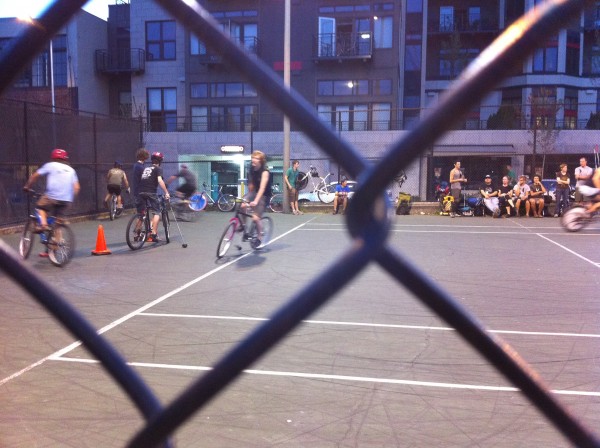 The Board of Park Commissioners has recommended an 18-month pilot for a new tiered court use policy that could allow dodgeball and bike polo to play at Cal Anderson without being renegade activities. People have continued playing both games, even though they were not technically allowed. But the new rules are more complicated than necessary, and they leave bike polo’s status up in the air.
The Board of Park Commissioners has recommended an 18-month pilot for a new tiered court use policy that could allow dodgeball and bike polo to play at Cal Anderson without being renegade activities. People have continued playing both games, even though they were not technically allowed. But the new rules are more complicated than necessary, and they leave bike polo’s status up in the air.
Basically, the new Parks rules (see our previous post) create three tiers for the city’s tennis courts. Tier one courts are the nicest, have many courts next to one another and can be used for tennis competitions (e.g. Woodland Park). These would be reserved for tennis only. Tier two courts may have a color coating, but there are fewer than three of them next to each other and they are not typically used for competitions. This tier includes Cal Anderson. Dodgeball and maybe bike polo would be allowed on these courts. Tier three courts are concrete, and the Parks plan would allow all sorts of activities here.
Now, here’s where things get complicated. At their meeting Thursday, the Board of Parks Commissioners, a volunteer citizen advisory committee for the Parks Department, passed a motion approving the plan as an 18-month pilot on up to three courts in the city. They then discussed it further and got tied into a Robert’s Rules of Order knot for a little bit before basically saying that Parks should move forward with Cal Anderson and Judkins Parks as their pilot courts.
However, in the end, they determined that bike polo should be allowed to play at Cal Anderson (even though the Parks’ plan says no to “stick” and “wheeled” sports at Cal Anderson), but that only one of the two courts should be the pilot court, while the other remains tennis-only. Technically, this would put dodgeball and bike polo in conflict Thursday evenings, since both groups typically play at the same time.
But wait, it gets even more complicated. The plan would also create a permit process that any non-tennis use would have to go through in order to use the courts. Organizers would propose their use to Parks, Parks would determine if it is “suitable” for the courts, Parks would post a public notice of the change-of-use, the public would have 30 days to respond to the proposed use, comments would be reviewed, then a decision would be made about whether that use can occur.
So, from what I can tell, this debate has not really been settled yet. Bike polo players I have spoken to would rather play at Judkins Park, but there are no lights there. Since it’s going to start getting dark at 4:30, Judkins is simply not going to work for them. The best solution would be for the city to install lights there, but that was not raised during the meeting as an option (I’m sure money is prohibitive).
Parks Superintendent Christopher Williams said they considered dodgeball to have “initiated that process,” so they will likely not have to go through the 30 days thing, etc. They seem set. But bike polo’s official status seems more in the air. If they were to go through the permit process, would they even be accepted? Did the Parks Board decision mandate that Parks allows bike polo at Cal Anderson? On top of all of this, what ability does Parks even have to enforce these rules at all? Bike polo and dodgeball have technically been against the rules for a while now, and they just kept playing (with much public support). It’s not clear how these new rules change that.
The question really is whether Parks should even want to get in the way of bike polo. It’s a use of public space that is inventive and has started a global movement. The city should support it. Creating rules that could force the game to continue as a renegade activity would close an opportunity for dialogue between Parks and players of the game. After all, it is not likely they will stop playing just because it’s against the rules.
So, we’ll see how things play out (pun intended). I wish a more simple solution had been found that more clearly promoted the creative uses for courts we have as well as uses that have yet to be organized. But I am glad Parks has recognized the need to expand their acceptance of non-tennis uses for courts and has created a framework for those uses. Perhaps in 18 months, the process can be refined and made easier and more open.







